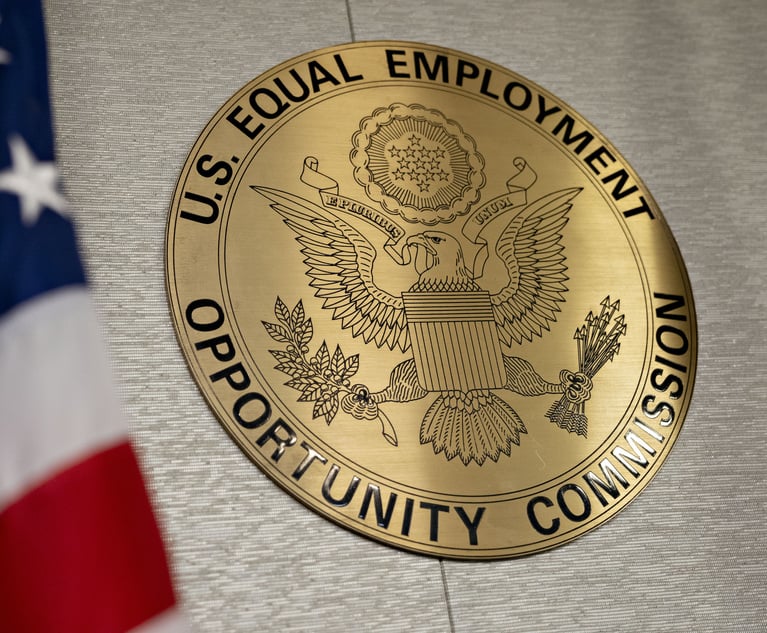Identity Issues
Rapidly changing legal landscape supports transgendered employees' rights.
September 30, 2007 at 08:00 PM
9 minute read
Col. David J. Schroer served with distinction in the U.S. Army for 25 years, commanding a Special Forces battalion during combat operations in Haiti and Rwanda and later directing a Special Operations unit charged with tracking and targeting international terrorist organizations. Shortly after retiring from the Army in 2004, Schroer applied for a job as a terrorism research analyst with the Congressional Research Service of the Library of Congress. Impressed by Schroer's credentials, the library quickly extended a job offer, agreeing to his salary demands.
What the hiring manager didn't know was Schroer is a transgendered person–someone whose gender identity is different from his or her assigned sex at birth–and about to legally become Diane J. Schroer, dress in feminine clothing and in every way present as a woman.
Schroer told the hiring manager about the gender transition at lunch while the hiring paperwork was in process. Schroer also showed the manager pictures of herself in traditional women's attire to allay any concerns about dressing in an appropriate manner. After conferring with colleagues, the manager withdrew the job offer the next day, allegedly commenting she thought Schroer would lack credibility because Congressmen wouldn't believe a woman could have Schroer's r?(C)sum?(C). Schroer responded with a lawsuit, still pending in D.C. District Court, that may open new legal avenues for those claiming discrimination based on gender identity.
While cases like Schroer's are showing up more frequently in the courts, there are no reliable statistics on the numbers of transgendered people in the workplace. In a rare published employer survey, J.P. Morgan Chase reported that 325 of its 160,000 employees, or roughly 0.2 percent, self-identify as transgendered. The actual percentage is thought to be much higher because many keep their gender identity issues secret, fearing the reaction of supervisors and co-workers to public affirmations of gender.
Until recently such employees typically moved to a different community when they started the gender transition process and sought employment under the new identity. Now they are more likely to come forward, expecting support from the employer on sensitive issues such as which restroom to use. They also are becoming increasingly confident about asserting their employment rights as court decisions turn in their direction and states and localities pass laws protecting them from workplace discrimination.
“In the past, the issue often wouldn't come up because the employee who was getting ready to transition would move to avoid the difficult problems of having to come to terms with people who knew them before,” says Lee Schreter, shareholder in Littler Mendelson. “Now with all the changes in the law you can expect that more and more people will come forward and ask for their employer's assistance.”
Changing Rulings
No federal law explicitly bars employment discrimination based on gender identity, and for more than 20 years courts ruled that transgendered plaintiffs were not protected by Title VII's ban on sex discrimination. Those rulings were based on the 7th Circuit's 1984 decision in Ulane v. Eastern Airlines Inc., which rejected a transgendered person's Title VII claim on the grounds Congress did not intend the law to prohibit anything other than the traditional concept of sex discrimination–discrimination against women because they are women or men because they are men.
More recently, however, some courts have accepted arguments that link gender identity discrimination to sexual stereotyping, which the Supreme Court banned in its 1989 decision Price Waterhouse v. Hopkins. In that case the court found a Title VII violation when supervisors passed over a woman for promotion because she did not dress and talk as they perceived a woman should. In 2004 the 6th Circuit applied the reasoning in Price Waterhouse to a gender identity case in Smith v. City of Salem.
“After Price Waterhouse, an employer who discriminates against women because, for instance, they do not wear dresses or makeup is engaging in sex discrimination,” the court wrote. “… It follows that employers who discriminate against men because they do wear dresses and makeup or otherwise act femininely are also engaging in sex discrimination.”
Several other courts adopted the 6th Circuit's reasoning in Smith, causing plaintiff's attorneys to focus on sexual stereotyping in their complaints on behalf of transgendered people. Schroer's case is attracting particular attention because Judge James Robertson explicitly rejected the sexual stereotyping argument last year but denied the Library of Congress' motion to dismiss anyway.
“The problem [Schroer] faces is not because she does not conform to the library's stereotypes about how men and women should look and behave–she adopts those norms,” Robertson wrote. “Rather, her problems stem from the library's intolerance toward a person like her, whose gender identity does not match her anatomical sex.” Rejecting the 7th Circuit's reasoning in Ulane, Robertson said it was time to reconsider whether discrimination against transgendered individuals is indeed discrimination “because of … sex.” He ordered Schroer's case to proceed.
“Schroer v. Billington is a very provoking case in terms of challenging traditional thought patterns,” says Trevor Lyons, associate at Connell Foley. “Judge Robertson took Ulane head on and said that this is discrimination based on sex, and to the extent you believe otherwise, you are outmoded and outdated.”
Shifting Ground
The evolution of court rulings protecting transgendered individuals is moving in tandem with efforts on the state and local level to explicitly include them as a protected class. By Jan. 1, 2008, 12 states and the District of Columbia, as well as approximately 90 cities and counties, will have laws on their books protecting employees' gender identity or expression. Some state and local laws include steep fines for violations–in New Jersey, for instance, an employer who violates the rights of a transgendered employee can be fined up to $50,000 under a law passed this year.
“This seems to be a movement that is gaining steam each year,” Lyons says. “Employers who stick their heads in the sand and don't recognize it's coming, or multi-state employers that don't prepare their people for the fact that this is now an issue in certain jurisdictions are doing themselves a disservice.”
But many transgendered individuals still have no protection and must rely on the good will of their employers in what can become a volatile environment. Witness the highly publicized case of Steve Stanton, city manager of Largo, Fla., who city commissioners fired in March 2007 in the wake of public outcry over a newspaper report that he was undergoing hormone therapy treatment and planning to become Susan Stanton. Three months later Stanton lost a bid to become Sarasota city manager, telling reporters later that it apparently is “too soon for a transgendered city manager.”
Among large corporations, however, the tide already is turning. Twenty-five percent of Fortune 500 companies include workplace protection for transgendered employees in their nondiscrimination policies, compared to 1 percent in 2000, according to a 2007 Human Rights Campaign (HRC) survey. Some 70 companies–including American Express, Eastman Kodak, IBM and Microsoft–provide comprehensive transgender health benefits, HRC reported, even though most insurance plans exclude coverage for gender transition treatment and may exclude transgendered individuals from all health coverage. Thirty-three major corporations publicly support the Employment Non-Discrimination Act, which would add sexual orientation and gender identity to the list of classes protected under federal law.
“A lot of these employers are way ahead of the law because they believe creating a more diverse work force fosters creativity, which in turn creates happier employees and more productivity,” says Jennifer Sease, partner in Fisher & Phillips.
Handle With Care
Still, the surprise of learning an employee you thought was a man is actually a woman can be disruptive to the workplace if not handled carefully.
“Anecdotally, there is a spike where it becomes sensational, and for 30 to 60 days it is what everyone is talking about,” Schreter says. “But if it is handled properly, it becomes a non-issue.”
Handling it properly requires being prepared in advance with nondiscrimination policies and procedures, including handling change of name on personnel records, ID badges and e-mail accounts; assuring confidentiality of medical records; making any necessary adjustments in dress codes; and addressing gender-specific facilities such as bathrooms and locker rooms.
The latter is often the most sensitive area for co-workers and can become a legal issue because of OSHA rules on bathroom access. But it need not become a stumbling block. Making single occupant, unisex bathrooms available to anyone who wants to use them often resolves that issue, as does education.
Stephanie Marnin, associate in the LGBT practice group at plaintiff's firm Outten & Golden, worked with a transitioning employee who employers told to use a restroom across campus.
“Often it's about people being afraid and not understanding that men who are going to assault women in bathrooms are not going to dress as a woman,” Marnin says. “In this case it was a matter of educating the employer and helping him educate others about the process the employee was going through and what it meant to her to have access to the women's bathroom. It worked.”
Above all, the way managers react will be closely watched and mimicked by other employees. Reiterating non-discrimination policies and addressing the transitioning employee as she or he wants to be addressed are actions that telegraph the manager's attitude to the staff.
“All of the employees are looking to management for leadership and guidance,” Sease says. “How management decides to handle the issue sets the tone for how the rest of the employees will react.”
This content has been archived. It is available through our partners, LexisNexis® and Bloomberg Law.
To view this content, please continue to their sites.
Not a Lexis Subscriber?
Subscribe Now
Not a Bloomberg Law Subscriber?
Subscribe Now
NOT FOR REPRINT
© 2025 ALM Global, LLC, All Rights Reserved. Request academic re-use from www.copyright.com. All other uses, submit a request to [email protected]. For more information visit Asset & Logo Licensing.
You Might Like
View All

‘Extremely Disturbing’: AI Firms Face Class Action by ‘Taskers’ Exposed to Traumatic Content
5 minute read
In-House Lawyers Are Focused on Employment and Cybersecurity Disputes, But Looking Out for Conflict Over AI
Trending Stories
Who Got The Work
J. Brugh Lower of Gibbons has entered an appearance for industrial equipment supplier Devco Corporation in a pending trademark infringement lawsuit. The suit, accusing the defendant of selling knock-off Graco products, was filed Dec. 18 in New Jersey District Court by Rivkin Radler on behalf of Graco Inc. and Graco Minnesota. The case, assigned to U.S. District Judge Zahid N. Quraishi, is 3:24-cv-11294, Graco Inc. et al v. Devco Corporation.
Who Got The Work
Rebecca Maller-Stein and Kent A. Yalowitz of Arnold & Porter Kaye Scholer have entered their appearances for Hanaco Venture Capital and its executives, Lior Prosor and David Frankel, in a pending securities lawsuit. The action, filed on Dec. 24 in New York Southern District Court by Zell, Aron & Co. on behalf of Goldeneye Advisors, accuses the defendants of negligently and fraudulently managing the plaintiff's $1 million investment. The case, assigned to U.S. District Judge Vernon S. Broderick, is 1:24-cv-09918, Goldeneye Advisors, LLC v. Hanaco Venture Capital, Ltd. et al.
Who Got The Work
Attorneys from A&O Shearman has stepped in as defense counsel for Toronto-Dominion Bank and other defendants in a pending securities class action. The suit, filed Dec. 11 in New York Southern District Court by Bleichmar Fonti & Auld, accuses the defendants of concealing the bank's 'pervasive' deficiencies in regards to its compliance with the Bank Secrecy Act and the quality of its anti-money laundering controls. The case, assigned to U.S. District Judge Arun Subramanian, is 1:24-cv-09445, Gonzalez v. The Toronto-Dominion Bank et al.
Who Got The Work
Crown Castle International, a Pennsylvania company providing shared communications infrastructure, has turned to Luke D. Wolf of Gordon Rees Scully Mansukhani to fend off a pending breach-of-contract lawsuit. The court action, filed Nov. 25 in Michigan Eastern District Court by Hooper Hathaway PC on behalf of The Town Residences LLC, accuses Crown Castle of failing to transfer approximately $30,000 in utility payments from T-Mobile in breach of a roof-top lease and assignment agreement. The case, assigned to U.S. District Judge Susan K. Declercq, is 2:24-cv-13131, The Town Residences LLC v. T-Mobile US, Inc. et al.
Who Got The Work
Wilfred P. Coronato and Daniel M. Schwartz of McCarter & English have stepped in as defense counsel to Electrolux Home Products Inc. in a pending product liability lawsuit. The court action, filed Nov. 26 in New York Eastern District Court by Poulos Lopiccolo PC and Nagel Rice LLP on behalf of David Stern, alleges that the defendant's refrigerators’ drawers and shelving repeatedly break and fall apart within months after purchase. The case, assigned to U.S. District Judge Joan M. Azrack, is 2:24-cv-08204, Stern v. Electrolux Home Products, Inc.
Featured Firms
Law Offices of Gary Martin Hays & Associates, P.C.
(470) 294-1674
Law Offices of Mark E. Salomone
(857) 444-6468
Smith & Hassler
(713) 739-1250







